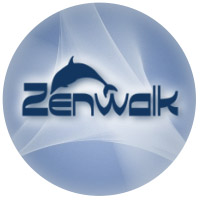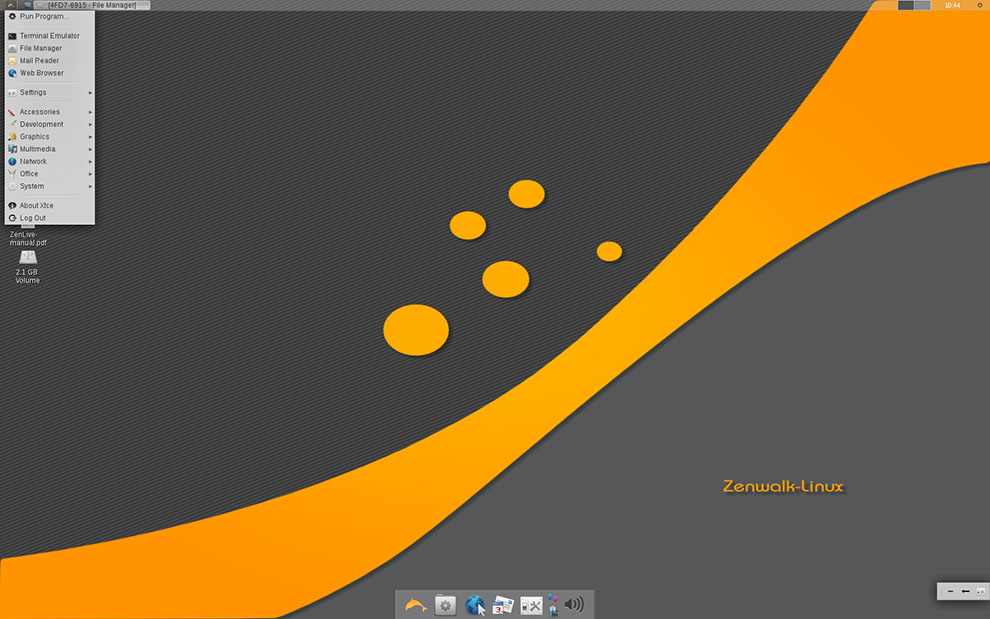
Zenwalk Linux is a very usable yet uncommon Linux OS. It is more than a single distribution. The developmental path and sketchy developer website may cast an unfavorable impression about Zenwalk’s trustworthiness as a serious computing platform. The ho-hum impression when first running the live edition does little to encourage users to take this Linux OS for a stroll.
Zenwalk Linux becomes a bit more impressive once you get beyond the awkward first-time experience, but it comes with a number of problems that might be prohibitive for a new user looking for an all-purpose Linux OS.
Zenwalk creator Jean-Philippe Guillemin built this Linux OS as a sort of customized computing tool so he could stop repeating the same modifications on systems after each new installation — you know, things like recompiling a more optimized and up-to-date kernel, removing numerous unused software and libraries, customizing the desktop and such.
That led to sharing his creation and following up on user suggestions to improve it. A community of users and supporters developed. This is not so evident from the website — but it is there.
In its current form, Zenwalk has a Slackware lineage, but it is more of its own thing than a Slackware thing.
In theory, this Linux distro is a fork of Slackware Linux, previously branded “Minislack.” It is fully compatible with official Slackware packages.
It practice, Zenwalk is an alternative to other fully functional lightweight Linux OSes that do not require full installation. It shares a family history with the likes of Puppy Linux, VectorLinux, Knoppix and Porteus, only it is much better and easier to use.

Zenwalk Linux is a Slackware derivative that uses a modified XFCE desktop.
What It Is
Zenwalk Linux has its roots as a GNU/Linux OS — it is much less of a distribution. That’s especially true of the live version, which is the focus of this review. It has no collection of packages. You run it as a finished version that needs no updating. That remains true even if you install Zenwalk Live on a hard drive or run it from a USB stick or the slower CD — yes, it is small enough not to need a DVD.
Zenwalk is simple to use and runs fast. It works right from the ISO burn as a complete desktop environment. It is highly configurable within the boundaries of the Xfce desktop.
The live version includes extras that normally are not available on live session distros until they are fully installed. For instance, it has recovery tools, partition tools, video games, and a whole lot more.
Web of Confusion
The Zenwalk website needs a serious makeover. If for no other reason, it is very confusing to find basic information about the software, support, and download options.
The developer website can tell a potential user a lot about a distro. In the case of Zenwalk, it suggests that the distro is a small shop operation. The website gave me a very poor impression of the OS. It appears to be very unorganized, with little useful information.
The ISO files do not show a release date. The downloads page indicates only a last post date. That may or may not mean a release date. For instance, the downlink for the supposedly latest version of 7.9.1 actually downloaded 8.0, a testing version.
This is caused in part by the sometimes rapid development of newer beta versions. Plus, most of the Zenwalk ISO downloads are for direct installation. They do not have the ability to run in a live session.
Multiple Offerings
It is difficult to find the most current versions of live, testing, and stable versions. Zenwalk does not have a live version beyond 7.4. The testing version is now at 8.0.
For example, figuring out which ISO file version to get is a user’s first problem. Too many versions lack details about their current status and intended users.
An unaware new user actually should not install Zenwalk Linux on a primary system, especially if the downloaded ISO file is a testing version.
The live version of 7.4 was released on April 29. An install-only version of 7.9.1 was released on 2014-06-19. There is no substantial difference other than not having a live environment.
For the record, version 7.9.1 and its replacement as of this writing — version 8.0 — are test versions. So, the only fully stable current release that is not a testing version seems to be version 7.4 Live. This is the focus of my review.
Using It
As a live edition Linux OS, you boot the computer and have your fun or productive work sessions. If you run it from a CD or DVD, changes are not permanent.
However, you can save modifications if you install it on a USB stick or a hard drive. In that case, you will need the superuser password — and therein lies a huge deal breaker.
In the discussions on the user forum and the details under the “Root User” section of the Zenwalk manual, the user name is supposed to be “root,” and the password is “ZenLive,” but they do not work.
Forum calls for help — still unanswered — go a long way back in time. At this point, you would expect the developer or someone active in the community to solve this ongoing problem.
Without having a usable password, you can not install or make changes to system defaults. Zenwalk uses netpkg as the distro’s custom package manager. It requires a root user password, as does the installation program.
User-Friendly Features
The XFCE environment is an easy-to-use desktop environment in its own right. It lacks the eye-candy integration with the functionality of other more modern interfaces like Unity, Cinnamon, or KDE.
However, it is an ideal choice for the design and mission of Zenwalk. Plus, the developer includes on the website a feature of sorts that most Linux developers ignore. This is a start-up user guide.
This PDF file is a great primer for first-time Linux users, as well as newcomers to Zenwalk Linux. It even talks users through how to use many of the software applications.
This user manual is well-written in a non-geeky style. It is supplemented with ample screenshots.
Under the Hood
Fancy is not a part of Zenwalk Linux. Functionality and workable lightweight infrastructure are. As the developer states in his postings, only usability matters.
The software changes in this latest live version release are a good example of how Guillemin carries out his mission. He replaced several applications of previous Zenwalk versions. For instance, Mplayer is now the multimedia player instead of Totem, Lxdm is the display manager instead of GDM, Xfburn is the CD: DVD burner instead of Brasero, and Geeqie is now the image viewer.
The XFCE desktop environment is updated to version 4.12 GIT — but Guillemin kept a few components of XFCE 4.10 for stability.
Install vs. Run Live
As a live system, Zenwalk has an anti-installation focus. It is a fully self-contained Linux platform without a hard drive installation. However, you can install it onto a hard disk drive while running from a live session. Use the Zenwalk-Live Installation utility in the System menu.
Zenwalk Live does not support UEFI, or Unified Extensible Firmware Interface. If you have a newer computer that came with Windows 8.X, be sure to set your firmware to legacy mode in order to boot Zenwalk Live.
Zenwalk Live 7.4 is the first Zenwalk Live version that does not utilize an AUFS (AnotherUnionFS)-enabled kernel. instead, It runs unionfs in userspace via FUSE (Filesystem in Userspace) on an unmodified Slackware generic kernel.
This will probably be the last Zenwalk Live version supporting 32-bit systems, according to Guillemin.
Look and Feel
The Xfce desktop is fairly straightforward. It has a desktop panel at the top of the screen. This holds the main menu button at the left end and the page/time/logout area at the far right.
Two preset virtual workspaces are available in the switcher applet to the left of the system icon area. The standard desktop icons form a vertical line along the left edge of the screen.
The AWN (Avant Window Navigator) dock sits at the bottom center of the screen.
Bottom Line
Zenwalk uses a text-based installer and LiLO (Linux Loader) boot loader. The Zenwalk software repository provides a lot fewer Slack packages than other Slackware distros provide. The Slackware line, in general, is less robust, with software available in .deb or .rpm distro counterparts.
I ran out of patience trying to find a solution to the password-not-working issue. This is certainly an area where the developer needs to provide a quick response.
I like the philosophy behind Zenwalk. I am less impressed with its lackluster desktop environment. I often used Xfce and liked it years ago, but it has grown old compared to other alternatives.
Zenwalk Linux could serve a useful purpose for users looking for an out-of-the-box portable live Linux solution, but power users and those with more demanding needs no doubt will find this distro lacking.
Suggest a Review
Is there a Linux software application or distro you’d like to suggest for review? Something you love or would like to get to know?
Email your ideas to me, and I’ll consider them for a future column.
And use the Reader Comments feature below to provide your input!























































Zenwalk is all but dead as a project. It’s own website attests to this fact as there is little activity, barely any users, etc. It’s a shame because Zenwalk was lovely. These facts are rather easily discernible by a glance at the Support Forum where the most recent post on the "we need contributors" thread was in 2010. So you’re passing judgement against a distro as though it had, by its own incompetence, ended up where it is today. This is a story from several years ago which, as a publication called "Linux Insider" you ought to have known.
As for ‘lack lustre desktop’ – it works as expected – as a Desktop is supposed to. Anything else is just fancy and totally unnecessary bells and whistles.
All in all this is a very poor article.
Yes, I’ve wanted to like ZenWalk, as I like the philosphy, but found the same issues. The UI could be upgraded with the use of JWM. I find some of the smaller distros use that in combination with other UIs to modernize the look and keep the UI low on resource usage.